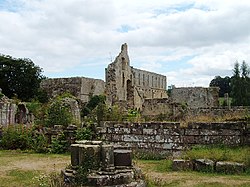Jervaulx Abbey

Jervaulx Abbey ruins
|
|
| Monastery information | |
|---|---|
| Order | Savigniac, Cistercian |
| Established | 1156 |
| Disestablished | 1537 |
| Mother house | Byland Abbey |
| Dedicated to | St Mary |
| Diocese | York |
| Controlled churches | Aysgarth, Ainderby Steeple, East Witton, West Witton |
| People | |
| Founder(s) | Akarius fitz Bardolph |
| Site | |
| Location | East Witton, North Yorkshire, England |
| Coordinates | 54°16′1″N 1°44′17″W / 54.26694°N 1.73806°WCoordinates: 54°16′1″N 1°44′17″W / 54.26694°N 1.73806°W |
| Grid reference | SE173855 |
| Visible remains | Substantial |
| Public access | Yes. Privately owned. |
Jervaulx Abbey in East Witton near the city of Ripon, was one of the great Cistercian abbeys of Yorkshire, England, dedicated to St. Mary in 1156.
The place-name Jervaulx is first attested in 1145, where it appears as Jorvalle. The name means 'the Ure valley', in French, and is perhaps a translation of the English 'Ure-dale', aka Yoredale. The valley is now called Wensleydale.
Initially a Savigniac foundation out of Normandy, the abbey was later taken over by the Cistercian order from Burgundy and responsibility for it was taken by Byland Abbey. Founded in 1145 at Fors near Aysgarth, it was moved ten years later to a site a few miles away on the banks of the River Ure. In 1145, in the reign of King Stephen, Akarius Fitz Bardolph who was Lord of Ravensworth, gave Peter de Quinciano, a monk from Savigny, land at Fors and Worton, in Wensleydale to build a monastery of their order. The monastery there was successively called the Abbey of Fors, Jervaulx, and Charity. Grange, 5 miles (8 km) west-north-west of Aysgarth, a hamlet in the township of Low Abbotside, in the parish of Aysgarth is the original site of Fors Abbey. After it was abandoned it was known by the name of Dale Grange and now by that of the Grange alone.
Serlo, then Abbot of Savigny, disapproved of the foundation, as it had been made without his knowledge and consent. He refused to supply it with monks from his abbey because of the great difficulties experienced by those he had previously sent into England. He therefore, in a general chapter, proposed that it should be transferred to the Abbey of Belland (Byland) which was closer and would be able to lend the necessary assistance required by the new foundation. Monks were sent from Byland and after undergoing great hardships because of the meagreness of their endowment and sterility of their lands, Conan, son to Alan, 1st Earl of Richmond, greatly increased their revenues and, in 1156, removed their monastery to a better location in East Witton, the present situation. Here the monks erected a new church and monastery, which, like most of the Cistercian order, was dedicated to St Mary. At the height of its prosperity the abbey owned half of the valley and was renowned for breeding horses, a tradition that remains in Middleham to the present day. It was also the original home of Wensleydale cheese. In 1279 Abbot Philip of Jervaulx was murdered by one of his monks. His successor, Abbot Thomas, was initially accused of the crime, but a jury later determined that he was not to blame, and another monk fled under outlawry.
...
Wikipedia

